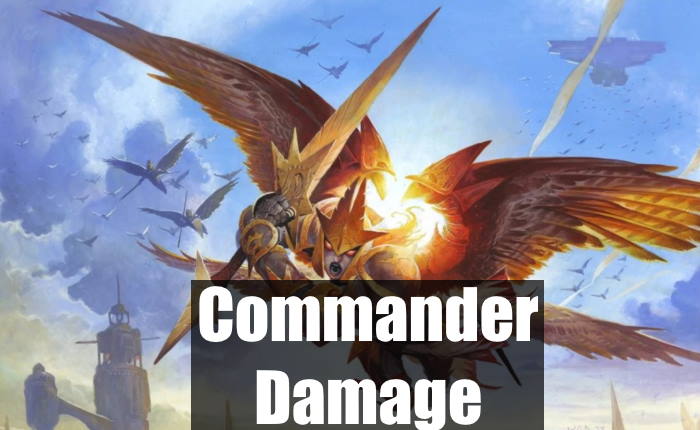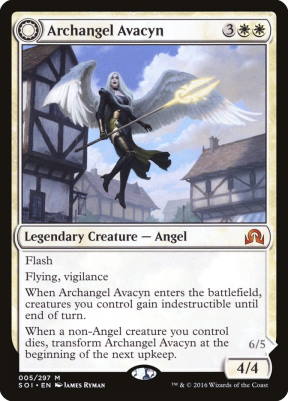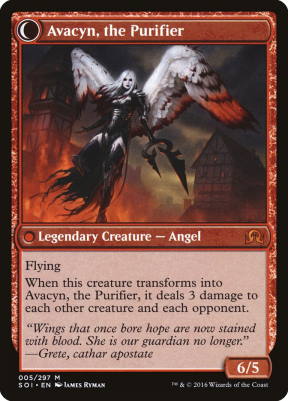Commander is perhaps the most beloved format in all of Magic: the Gathering. Its incredible diversity is one of the core aspects that keep players coming back. Crazy card interactions, huge swings in gameplay, alternative ways to win, Commander has it all. In this article, I’ll explain everything you need to know about one alternative win method: Commander damage.
Commander damage is a damage system unique to Commander. Each player starts the game with zero. Whenever a player’s commander deals combat damage to a player, the defending player gains “Commander damage” equal to the amount of combat damage dealt. This damage remains throughout the game. If at any time, a player accumulates 21 or more points of damage from a single commander, that player loses the game.
Although the rule is pretty straightforward, there’s still quite a bit of information players need to grasp to fully understand it and its impact on gameplay. Read on for a detailed breakdown, as well as a list of the best commanders for exploiting this alternative win condition.
What Is Commander Damage?
Commander damage is a rule stating that any player who receives 21 or more points of damage from a single commander, loses the game. This means that even though you start with a cushy 40 point life total, you can’t afford to ignore all of your opponents creatures.
How Does It Work?
It’s pretty simple really. Lets say you’re using The Ur-Dragon as your commander. During your attack phase, you decide to swing at one of your opponents who has no blockers. The Ur-Dragon lands and does ten points of combat damage to your opponent. They lose ten life, and also gain ten points of Commander damage. The next turn, you make the exact same attack. You land again, and your unfortunate victim now has a total of 20 damage from The Ur-Dragon.

One turn later, your opponent still can’t block, and you repeat your brutal attack. Your opponent goes to 30 points of damage from your commander. Since this is over the limit of 21, they’re knocked out of the game regardless of however much life they have left. They curse at you for swinging at them three times in a row with a 10/10 dragon, and leave the table.
RELATED: MTG Companion: How It Works And What It Does
How Much Commander Damage Can You Take?
Each player can take as much as 20 points of damage from any one commander, but no more. Once you get to 21 you lose the game. There’s a somewhat common misconception that 20 is the lethal number. This is probably due to 20 being the starting life total in most formats. The official number, however, is actually 21. Once you get to 21, you’re dead and gone.
It’s important to note here that each player’s commander deals its own separate damage. It doesn’t add together the way combat damage does on your life total. So in theory, you can receive up to 20 points of damage from each one of your opponents commanders and still survive.
Does It Need To Be Combat Damage?
Yes, it does. Only combat damage dealt by an attacking commander counts. This means that effects and abilities never count toward the 21. Let’s say Ruric Thar, the Unbowed is your commander. Whenever a player casts a non-creature spell, Ruric’s ability will trigger and that player will take six damage, therefore losing six life. They won’t, however, take any Commander damage since Ruric’s damage wasn’t dealt through combat.
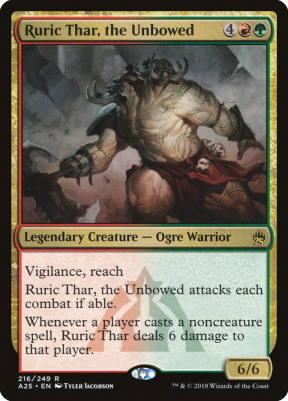
If damage dealt by abilities counted, creatures like Heartless Hidetsugu would be insanely overpowered.
How Does It Work With Partner?
The Partner mechanic lets players have two different commanders at once. However, if you’re hoping to use your duo of generals to deal twice the amount of Commander damage, you’ll be sorely disappointed.
If you’re playing with two partnered commanders, each one deals its damage separately. This means you’ll have to deal 21 points of combat damage to an opponent with one of your commanders independently. Their damage doesn’t add together.
How Does It Work With A Stolen Commander?
There’s little else in MTG as fun (or annoying depending on which side you’re on) as stealing your opponents creatures. Stealing an opponent’s commander is a particularly wicked and powerful move. So how does Commander Damage work with a stolen commander? I’ll explain.
Damage is tracked on an individual commander-to-player basis. It doesn’t matter who controls the commander at any given time. So, for example, Player One has attacked Player Two with his commander – let’s say The Ur-Dragon again – twice throughout the game. Player Two now has 20 damage from The Ur-Dragon. Player Three then casts Treachery and steals Player One’s Ur-Dragon. Next turn, Player Three attacks Player Two with The Ur-Dragon. Even though the creature has a new owner, Player Two still receives ten more Commander damage from The Ur-Dragon, taking his total past 21 and knocking him out of the game.
Additionally, its possible for a stolen commander to deal damage to its owner! Knocking a player out with their own commander is a surefire way to earn both hatred and respect from your playmates.
RELATED: Baldur’s Gate Spoilers: What We Know So Far
How Does It Work With A Transformed Commander?
There are several creatures in MTG that can transform in some way or another. Take Archangel Avacyn // Avacyn, The Purifier for example. So how do transformations affect Commander damage? After all, the transformed card has a new name and abilities. So does each version of the card deal separate damage?
The answer is no; transformations have no affect on damage accumulation. If you deal four damage with Archangel Avacyn and then transform her to Avacyn, The Purifier and deal six more to the same player, that player will have ten damage from your commander.
The way the rules work in MTG, the card you choose as your commander remains your commander no matter what. Even if someone casts Turn to Frog on your general, it still counts as the same commander.
Why Does Commander Damage Exist?
Commander started with the Elder Dragons from the Legends set (hence the original EDH or “Elder Dragon Highlander” name). Each of these dragons were 7/7s, and so the idea was that if you got hit three times by your opponents commander, you should die.
Nowadays, this alternative win strategy is important to the format for a few different reason. First of all, it provides an exciting extra element to gameplay. Not every game ends the same way for every player, which is a nice bit of variance.
Secondly, it helps speed up the format. Commander games can take a long time. Being able to knock out other players after just 21 damage instead of 40 is a nice shortcut and adds a bit of urgency and intensity to Magic’s slowest format.
Thirdly, it emphasizes the importance of the commander. If commanders are out, you better pay attention to them. Not only are they powerful creatures integral to your opponents strategy, but they can also quickly take you out of the game if you let them.
Last but not least, it opens up lots of fun possibilities in deck-building. Most decks function around dropping your opponents life-totals to zero. Commander damage, however, opens up an entirely new path to victory for players to pursue.
Best Voltron Commanders
Swinging with your commander is a great way to win games quickly. To pull this off, however, you’ll need the right legendary creature.
This type of strategy, known as “voltron“, wants a commander with high power or a way to easily increase its power, usually via enchantments, equipment, or +1/+1 counters. Naturally, having higher power means you’ll only need to land a few times to knock your opponents out of the game.
Additionally, evasion is essential for these voltron commanders. “Evasion” refers to an ability that makes it easier to land an attack. The most common of these abilities is Flying, but there are plenty of other good ones too. It’s also important to be able to protect your commander in this strategy. Cards with Hexproof and Indestructible are good choices.
Here are my picks for the best voltron commanders in the game today.
5. Isamaru, Hound of Konda

Isamaru, Hound of Konda doesn’t have any built in evasion or protection. He actually doesn’t have any abilities at all. He is, however, extremely cheap to cast. Isamaru costs just one single white mana, meaning you’ll be able to cast him your very first turn, every game.
You don’t need evasion when your opponents haven’t had a chance to cast any blockers. And if/when your opponents kill him, since he’s so cheap, you can easily cast him over and over again from the command zone. It really starts to get nasty when you pair Isamaru with cheap enchantments and equipment. My favorite is Blackblade Reforged.
4. Bruna, Light of Alabaster
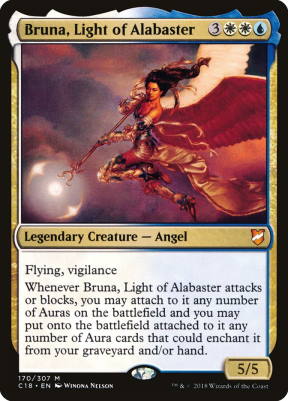
Bruna, Light of Alabaster is a damage machine. She’s a 5/5 with Flying and Vigilance, making it easy to get in powerful attacks right away. And her ability is insane! Every time she attacks, it lets you attach any aura cards on the battlefield (including your opponents side) to Bruna.
It also lets you put any number of auras from your graveyard and hand onto the battlefield attached to Bruna. It’s easy to imagine how she can quickly get huge. She doesn’t have any built-in protection, but it’s pretty easy to add with an aura.
3. Avacyn, Angel of Hope

Avacyn, Angel of Hope checks all of the boxes for a great voltron commander. At 8/8 she has plenty of power as soon as she’s cast. She has Flying, making her difficult to block. She has Vigilance, making her a great defensive player. And she has Indestructable, making her very hard to get rid of.
The only downside to Avacyn is her high mana-cost. While she might not come out as fast as other commanders, once she lands on the field, she’s a force to be reckoned with.
2. Zur the Enchanter
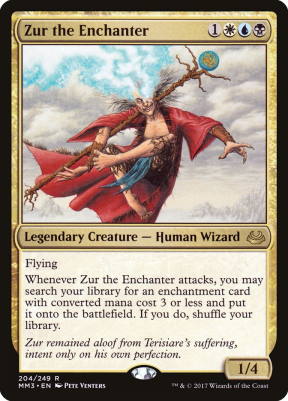
Costing just four mana to cast, Zur the Enchanter is one of the cheaper voltron commanders. Casting your commander early is always nice since it allows you to get in some easy damage to opponents who haven’t built up their
Every time you attack with Zur, you get to search your deck for any enchantment card with mana-value three or less and attach it to him for free. This tutor effect gives Zur a ton of power, and also gives your deck great versatility. Oh, and did I mention he has flying as well?
1. Narset, Enlightened Master
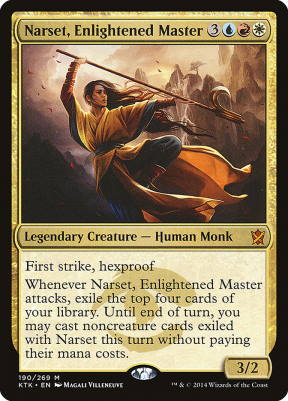
Narset, Enlightened Master might be the most fun voltron commander out there. For six mana you get a 3/2 body with built in First Strike and Hexproof. As with most of these creatures, however, the real fun lies in her ability. Whenever Narset attacks, you get to exile the top four cards of your library. Until the end of your turn, you get to cast any non-creature spells you exiled with her for free.
Four free spells per turn. Just imagine all the possible shenanigans! This is especially nasty if you fill your deck with cards that grant extra turns. The one downside with Narset is that she only has pseudo-evasion in the form of First Strike.
RELATED: The Best MTG White Tutors
End Step
Commander damage is an important part of the Commander experience. This special win condition is one of many aspects that gives the format its signature variety and unpredictability. Whether you’re building a deck based around it, or trying not to die to it yourself, Commander damage adds intensity to an already wild format. I hope this article has helped you master all the nuances of swinging with your favorite general and tallying up the consequential damage.
